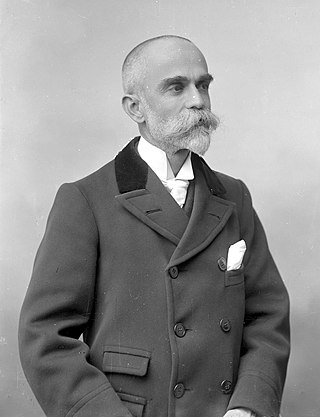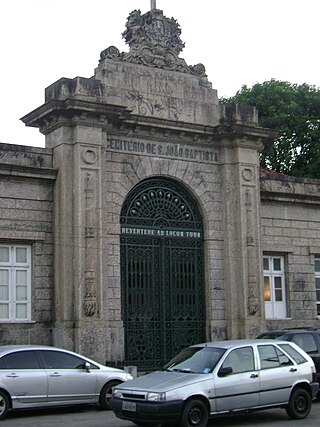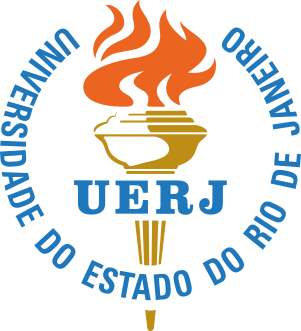
Rio de Janeiro is one of the 27 federative units of Brazil. It has the second largest economy of Brazil, with the largest being that of the state of São Paulo. The state, which has 8.2% of the Brazilian population, is responsible for 9.2% of the Brazilian GDP.

Bernardino Luís Machado Guimarães, GCTE, GCL, was a Portuguese political figure, the third and eighth president of Portugal.

The Cemitério de São João Batista is a municipal necropolis originally owned and operated by the Santa Casa da Misericórdia do Rio de Janeiro, and run, since August 2014, by the private company Rio Pax.
Bento Ribeiro is a middle-class neighborhood in the North Zone of Rio de Janeiro, Brazil. It is a suburban area in the vicinity of Marechal Hermes and Oswaldo Cruz and Vila Valqueire. Bento Ribeiro owes its name to Bento Manuel Ribeiro Carneiro Monteiro, mayor of Rio de Janeiro between 1910 and 1914. It is the birthplace of the professional football player Ronaldo and the place where the famous television host Xuxa lived in her childhood.

Darcy Ribeiro was a Brazilian anthropologist, historian, sociologist, author and politician. His ideas have influenced several scholars of Brazilian and Latin American studies. As Minister of Education of Brazil he carried out profound reforms which led him to be invited to participate in university reforms in Chile, Peru, Venezuela, Mexico and Uruguay after leaving Brazil due to the 1964 coup d'état.

João Ubaldo Ribeiro was a Brazilian writer, journalist, screenwriter and professor. Several of his books and short stories have been turned into movies and TV series in Brazil. Ribeiro was a member of the Brazilian Academy of Letters, being elected in 1994. At the time of his death many considered him to be Brazil's greatest contemporary novelist.

The Sambadrome Marquês de Sapucaí is a purpose-built parade area built for the Rio Carnival in Rio de Janeiro, Brazil. The venue is also known as Passarela Professor Darcy Ribeiro or simply the Sambódromo in Portuguese or Sambadrome in English. It is located in the downtown area of Cidade Nova in Rio de Janeiro, and is the place where samba schools parade competitively each year during the Rio Carnival. The parades attract many thousands of Brazilians and foreign tourists each year, and the structure is also used as a multi-purpose performance venue. The structures of the Sambadrome were designed by the architect Oscar Niemeyer (1907–2012), and represent his first major work after the end of the Brazilian dictatorship of 1964–1985.
José Mariano de Conceição Vellozo (1742–1811) was a Colonial Brazilian botanist who catalogued specimens, for example: Cedrela fissilis Vell. in Florae Fluminensis. He was born in Tiradentes, formerly called São José do Rio das Mortes, state of Minas Gerais; and died in Rio de Janeiro, state of Rio de Janeiro. While at the University of Coimbra in Portugal in the 1790s he worked with Martim Francisco Ribeiro de Andrada in translating works on mineralogy and agriculture. The standard author abbreviation Vell. is used to indicate this person as the author when citing a botanical name.

São Gonçalo is a municipality in Rio de Janeiro, Brazil, in the Southeast region. It is located in the Metropolitan Region of Rio de Janeiro, having land limits with the municipalities of Niterói, Maricá and Itaboraí, and a maritime limit, by Guanabara Bay, with the capital, Rio de Janeiro. According to the 2022 census, it has a population of 896,744 inhabitants, making it the second most populous municipality in the state and the 18th most populous in the country.

Rio de Janeiro State University is a public research university in the state of Rio de Janeiro, Brazil. It is one of the largest and most prestigious universities in the country. The university's law and medical schools are among the best in the nation. Its Biology, Social Science, Nursing and Philosophy courses are also highly praised, as stated by Guia do Estudante.
Linhas Aéreas Wright Ltda was a Brazilian airline formed in 1947. In 1948 it was sold to Real Transportes Aéreos.

Martim Francisco Ribeiro de Andrada was a Brazilian politician who played a leading role in the declaration of Brazil's independence and in the government the following years. He was twice Minister of Finance.

Events in the year 1986 in Brazil.

Events in the year 1984 in Brazil.

Carlos Francisco Theodoro Machado Ribeiro de Lessa, better known simply as Carlos Lessa was a Brazilian economist and professor.

With the 1964 Brazilian coup d'état, on April 2 the National Congress of Brazil declared the presidency of the Republic occupied by João Goulart vacant. Since the vacancy was foreseen for the president's departure from the country without the authorization of Congress, which was not the case, the act had no constitutional support. However, it formalized the coup, transferring the post to the president of the Chamber of Deputies, Ranieri Mazzilli, until the indirect election of General Castelo Branco, the first military president of the dictatorship (1964-1985), days later.

Eunice Durham was a Brazilian anthropologist.

Rosiska Darcy de Oliveira is a Brazilian journalist, writer and academic. Her works mainly deal with topics such as feminism, education and contemporary life. She was also a staunch opponent of the dictatorship in the country, established by the 1964 coup d'etat.

Camila Jourdan is a Brazilian philosopher, anarchist activist, and university professor. A specialist in the thought of Ludwig Wittgenstein and a teacher at Rio de Janeiro State University (UERJ), she is also known for being the target of a flawed prosecution by Brazilian authorities for her participation in the 2014 protests in Brazil, where she was accused by the country's security forces of preparing and making Molotov cocktails. Initially sentenced to six years in prison, she was ultimately fully acquitted in 2024 by the Supreme Federal Court.















